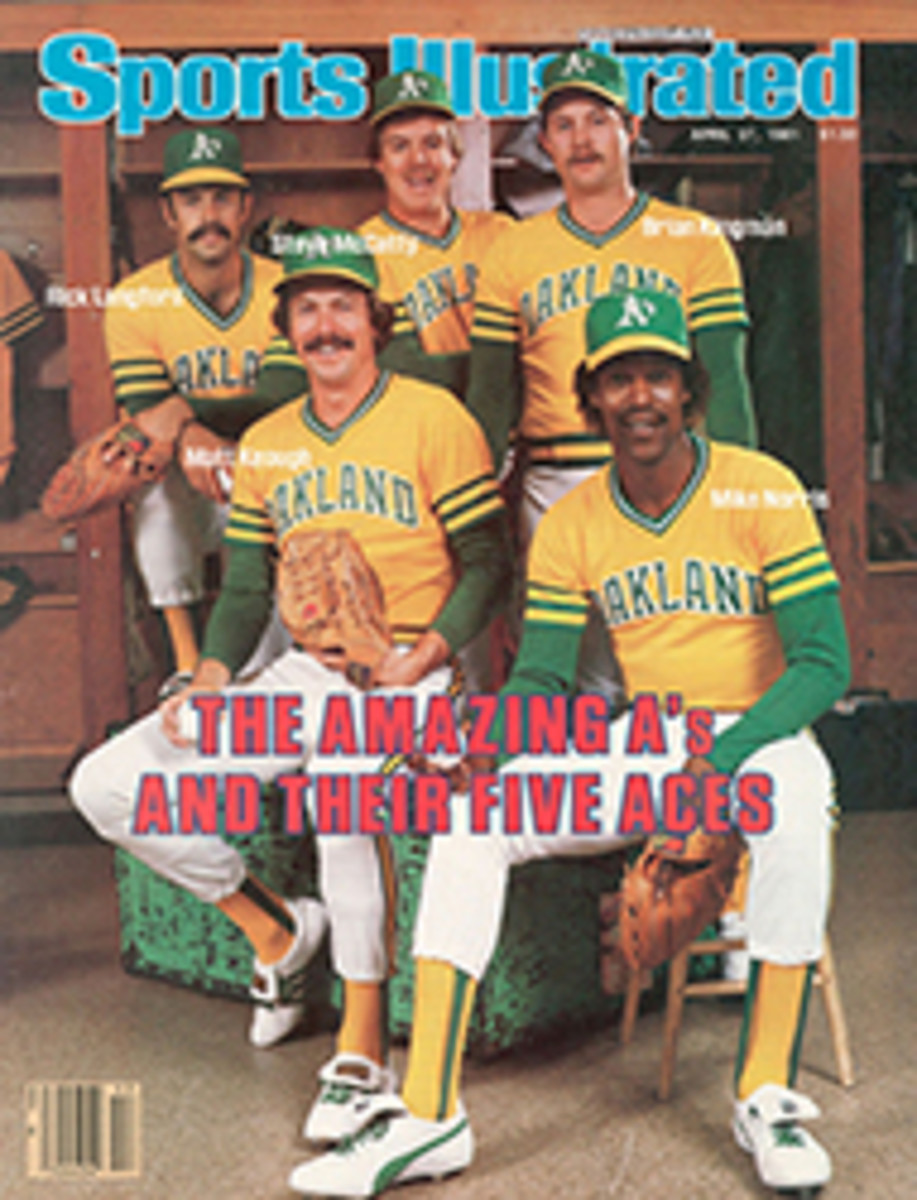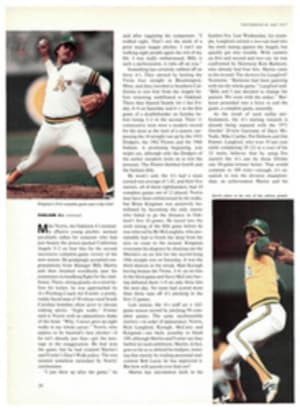
ENTHUSED AMERICANS NOW EMULATE SCOTS WHA HAE WI' SHEEPDOGS TREAD
A trim, ruddy-faced Scot named Jack Knox clasps the top of a shepherd's crook as he stands before a tall wooden post in an Alabama meadow. Beside him a small black and white border collie peers out to the far end of the field 300 yards away, where five sheep are hopping out of the end of a livestock trailer. Now a woman on horseback keeps the sheep in place as the trailer is driven away. The dog quivers with excitement as his master gives him a signal—a downward-pointing finger—that sends him tearing off along one side of the field.
Giving the sheep a wide berth, the collie circles back behind them. Knox gives a "tweet" by blowing through two fingers placed in his mouth and the dog stops cold, drops down low in the grass and fixes the sheep with a steady, mesmerizing eye, causing them to mill about nervously. Two long whistled notes bring the dog to his feet and into a menacing, step-by-step approach. The sheep move forward in a group, heading toward a seven-yard gap between two lengths of wooden fence, but then they veer off left. "Come by, Craig!" Knox shouts. The collie zooms wide around the left flank of the sheep, nudging them as if by magic, from 50 feel away, back into a line that takes them trotting neatly through the gap. As Craig follows them through, Knox bellows to the dog. "Lie down, mon! Take your time!"
When Knox cries. "Way to me!" to bring Craig craftily around the right flank of the sheep, there are murmured echoes of "Way to me!" from some of the spectators in folding chairs behind him. They are sheepdog handlers, too, competitors in trials that had them out every day for a week last October.
These particular trials, the American Grand Finals, drew some three dozen handlers, with two or three dogs apiece, from all over the South and Midwest to this farmland outside Dothan, Ala. Raymond MacPherson, an international sheepdog authority, came all the way from his 4,000-acre sheep farm in the north of England to judge the trials. Tall, with a craggy countenance, MacPherson presided over the trials sternly, allowing no crime or misdemeanor on the part of dog or master to go unremarked in the somewhat complicated scoring, which he handled entirely on his own.
A bad error in border colliemanship is allowing a dog to lose control with that masterful evil eye of his so that the sheep (or other animals) run off helter-skelter while the shepherd, back at the stake, shouts himself hoarse or whistles himself out of breath. But an even worse offense than this is "gripping," meaning dog bites sheep. That dog scores zero.
The idea at these competitions, which have become so very popular in the last few years that there is usually one in progress somewhere in the U.S. every weekend, is to simulate the regular work-a-day chores of the border collie as he gathers, separates and drives livestock on sheep and cattle ranches. These demonstrations originated in Scotland more than a century ago and in Britain and Ireland still attract mainly working shepherds, who take a few days off to compete. American trials, on the other hand, attract a new breed of sportsman whose main interest is running his dogs in competition. Often the dogs are brought to the U.S. from Scotland already trained (they cost up to $3,000 plus $600 air fare) with a tape recording of the original trainer's voice for the new owner to imitate. The attempts of some of the handlers from Tennessee or Texas to catch nuances of the Scottish accent have not been very successful.
"For us this is what a game of golf is for other people," says Jim Bob McEwen, who runs a poultry farm in Decatur, Ind., where his dogs regularly move a flock of 9,600 turkeys from one field to another. Many dog owners load up a van or pickup with two or three portable kennels and take their collies to local weekend competitions or to bigger events, such as the Dothan trials, which can involve days of driving. Two Tennessee cattlemen, Stan Moore of Knoxville and Bill Wyatt of Kingston, had put 3,600 miles on their trucks to appear in a series of trials in Texas before arriving in Alabama. Because the dogs must work with livestock frequently in order to keep sharp for the trials, many owners who don't raise sheep—most of the American handlers are cattlemen—go out and buy a few for their dogs to chase around in practice.
Border collie people are convinced their dogs are the smartest of all breeds. "They have such a desire to please," says Wyatt, a tall Jimmy Stewart type who uses his dogs to herd cattle into a corner of a field when the cattle are to be sprayed. "The dogs know which ones have been sprayed because those don't have any flies around them," says Wyatt.
First-time spectators at a trial need some time to figure out what is going on. Before a row of people sitting on folding chairs or in truck cabs, a handler stands at a post making high-pitched, shrill whistles that seem hardly loud enough to carry to the dog. The sheep stray here and there, the dog runs, circles, stops and starts, and there seems no point to it all until you learn what the standard route consists of: bringing in the sheep through the first gap (the fetch), driving them outward through another gap, and across the field to still another (the drive), and then moving them into an eight-by-eight-foot fenced enclosure without coming into contact with the sheep (the penning). Finally, the handler tries to poke his crook between one sheep and the rest of the herd so that his dog can cut the single animal away from the others. This produces much milling about, and the handlers say the shed, as the operation is called, depends for its success on the luck of the draw, for some sheep are tractable and some are not. Some will stick together as if glued and others will shoot away like spilled marbles and disappear among the parked pickups and campers, causing lost points and ending the trial before its 11-minute limit has been reached. Each part of the trial is worth 10 or 20 points; a perfect score is 110. The high scorer in the finals, at Dothan, was Knox with his dog Craig, who made 95. That won Knox a huge silver tray from the Governor of Alabama, Fob James.
Border collies aren't bred for beauty but make up_for their sometimes scruffy looks by a willingness to obey, to please the master, to do their duty. R.T. Averitt, who raises sheep in Trenton, Ky., says he has a dog who can think for himself. "I gave him the wrong order once and he just stopped, stared at me and waited until I corrected the command," Averitt says. But a Scottish writer on the breed, R.B. Robertson, doesn't agree. Says Robertson: "The brain behind the marvelous maneuvers the dog executes upon the hill is the brain of the shepherd. The intelligence quotient of the dog, if assessed on human scale, would be well down in the imbecile grade."
When each trial ends, the master tells the dog, "That'll do," which is supposed to bring him off the animals he's been herding and over to his owner's hand. The dog will get a pat on the head if he has done well. Neither hand nor stick is used in the dogs' training, the worst punishment for disobedience being the master's words, in a low voice—preferably with Scottish burr, of course—"Come in, ye wee whore ye!"
A British government estimate, based on pedometers attached to working dogs, is that the average dog runs nearly 100 miles a day, or about 14 miles for every mile hiked by the shepherd. Neal Crook, a kennel owner from Waco, Texas, says the collies are much better than ranch hands because, for one thing, "You don't have to roust 'em out of the drunk tank in the county jail on Monday morning." Their pay is a bed in a box in a barn and maybe a note of pride in the farmer's voice when he cries, "That'll do!"
ILLUSTRATION
ALICE BRICKNER

